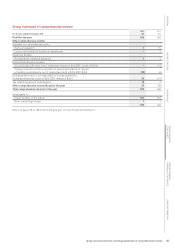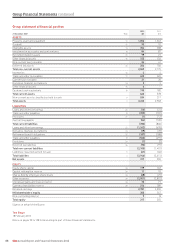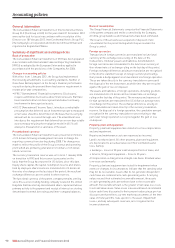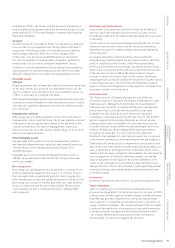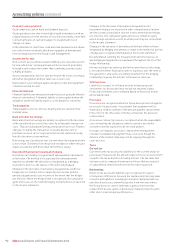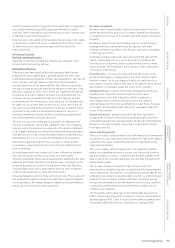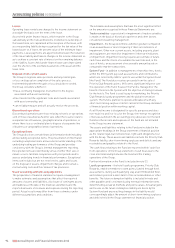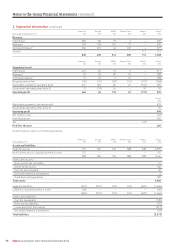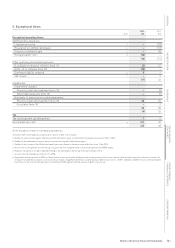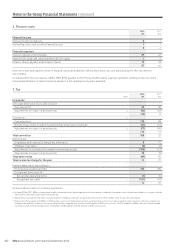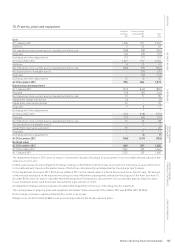Holiday Inn 2012 Annual Report Download - page 97
Download and view the complete annual report
Please find page 97 of the 2012 Holiday Inn annual report below. You can navigate through the pages in the report by either clicking on the pages listed below, or by using the keyword search tool below to find specific information within the annual report.
OVERVIEW BUSINESS REVIEW GOVERNANCE
GROUP FINANCIAL
STATEMENTS
PARENT COMPANY
FINANCIAL STATEMENTS OTHER INFORMATION
Accounting policies 95
Retirement and other post-employment benefits – the cost
of defined benefit pension plans and other post-employment
benefits is determined using actuarial valuations. The actuarial
valuation involves making assumptions about discount rates,
expected rates of return on assets, future salary increases,
mortality rates and future pension increases.
Tax – provisions for tax accruals require judgements on the
interpretation of tax legislation, developments in tax case law
and the potential outcomes of tax audits and appeals. In addition,
deferred tax assets are recognised for unused tax attributes to the
extent that it is probable that taxable profit will be available against
which they can be utilised. Judgement is required as to the amount
that can be recognised based on the likely amount and timing of
future taxable profits. Deferred tax balances are dependent on
management’s expectations regarding the manner and timing
of recovery of the related assets.
Other – the Group also makes estimates and judgements in the
valuation of franchise and management agreements acquired
on asset disposals, the valuation of financial assets classified as
available-for-sale, the outcome of legal proceedings and claims
and in the valuation of share-based payment costs.
New standards issued but not effective
The following accounting standards, amendments and
interpretations with an effective date after the date of these
Financial Statements have not been adopted early by the Group
and will be adopted as set out below. Unless otherwise indicated,
the Directors do not anticipate that the adoption of these standards,
amendments and interpretations will have a material impact on the
Group’s reported income or net assets in the period of adoption.
• IAS 1 (Amendment) ‘Presentation of Financial Statements’,
which is effective from 1 July 2012, changes the grouping of items
presented in other comprehensive income (OCI) so that items
which may be reclassified to profit or loss in the future are
presented separately from items that will never be reclassified.
• IAS 19 (Revised) ‘Employee Benefits’, which is effective from
1 January 2013, introduces numerous changes including the
removal of the option to defer recognition of some actuarial
gains and losses (‘the corridor mechanism’) and the concept of
expected returns on plan assets. The Group currently recognises
all actuarial gains and losses in OCI, therefore the removal of
the corridor mechanism will have no impact on financial
performance or position. The impact of calculating the expected
return on plan assets (after relevant asset restrictions) using
the same interest rate as applied to discounting the benefit
obligations is expected to result in a higher operating profit
charge of approximately $3m in 2013 compared with the 2012
charge under the current version of IAS 19.
• IAS 28 (Amendment) ‘Investments in Associates and Joint
Ventures’, which will be adopted by the Group from 1 January
2013, has been renamed as a consequence of the new IFRS 11
and IFRS 12 (see below) and describes the application of the
equity method to investments in joint ventures in addition
to associates.
• IFRS 10 ‘Consolidated Financial Statements’, which will be
adopted by the Group from 1 January 2013, introduces a single
control model for all entities, including special purpose entities,
which will require significant judgement to determine which
entities are controlled and therefore consolidated in the Group
Financial Statements. Based on the preliminary analyses
performed, IFRS 10 is not expected to have any material impact
on the investments held by the Group.
• IFRS 11 ‘Joint Arrangements’, which will be adopted by the Group
from 1 January 2013, eliminates the option to account for jointly
controlled entities (JCEs) using proportionate consolidation. The
Group currently accounts for its JCEs using the equity method
which is the requirement of IFRS 11.
• IFRS 12 ‘Disclosure of Interests in Other Entities’, which will be
adopted by the Group from 1 January 2013, incorporates all of
the disclosures required in respect of an entity’s interests in
subsidiaries, joint arrangements, associates and structured
entities. The requirements are extensive and likely to result in
new disclosures in the Group Financial Statements.
• IFRS 13 ‘Fair Value Measurement’, which is effective from
1 January 2013, establishes a single source of guidance under
IFRS for fair value measurements. IFRS 13 does not change
when an entity is required to use fair value, but rather provides
guidance on how to measure fair value when fair value is required
or permitted. Based on the preliminary analyses performed,
IFRS 13 is not expected to have a material impact on the Group’s
Financial Statements.
• IFRS 9 ‘Financial Instruments: Classification and Measurement’,
which is effective from 1 January 2015, introduces new
requirements for classifying and measuring financial assets
and financial liabilities and, when finalised, will address hedge
accounting and impairment of financial assets. The Group will
assess the impacts when the final standard is issued.
Note: with the exception of IFRS 9, all of the above will be adopted
by the Group with effect from 1 January 2013. IAS 28 (Amendment),
IFRS 10, IFRS 11 and IFRS 12 have been endorsed for adoption by
the EU with effect from 1 January 2014 and are therefore being
adopted early by the Group.


